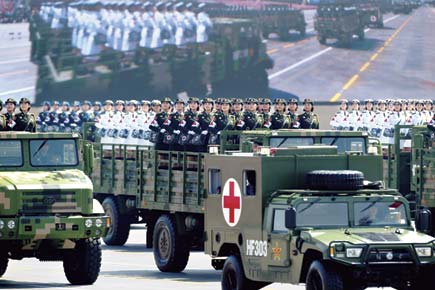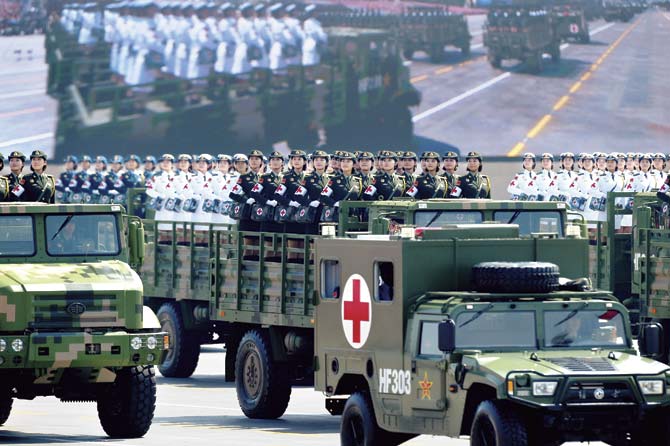For the past week, observers of China have been expecting Beijing to announce a series of reforms to drastically restructure and reshape the People’s Liberation Army

 For the past week, observers of China have been expecting Beijing to announce a series of reforms to drastically restructure and reshape the People’s Liberation Army. The step was expected to follow the September 3 announcement during the massive military parade in Beijing that the force would cut 3,00,000 personnel and bring its force down to 2 million.
For the past week, observers of China have been expecting Beijing to announce a series of reforms to drastically restructure and reshape the People’s Liberation Army. The step was expected to follow the September 3 announcement during the massive military parade in Beijing that the force would cut 3,00,000 personnel and bring its force down to 2 million.
ADVERTISEMENT
So far this has not happened, but it is a question of when, rather than if. Beijing’s imperatives for reform are obvious — if it wants to cope with an adversary like the US, it needs to change its orthodox, land-oriented military into a flexible and agile force which can be used on to defend the country’s borders, but also for missions afar.

The People's Liberation Army participates in a military parade at Tiananmen Square in Beijing on September 3 to mark the 70th anniversary of the victory over Japan and the end of World War II. Pic/AFP
According to the Chinese media and commentators, the major restructuring would be from top to bottom. At the very top, the four key departments — general staff, general political, general logistics and general armaments — would be reorganised into the general political, logistics and armaments departments which would now report to the general staff department, which would, in turn, be supervised by the all-powerful Central Military Commission which is chaired by President Xi Jinping. A separate reporting line would, for the first time, have the new general staff department report to the Ministry of Defence as well.
The current division of the PLA into seven military regions, as well as the Air Force and the Navy would give way to four integrated military regions — the south-west, south-east, north-east and north-west strategic zones. The size of the Army and Air Force would be drastically reduced and that of the Navy marginally. There would be a new 50,000 strong space force and all this is not counting the 2nd Artillery which handles China’s nuclear and conventional missile forces. According to one estimate, the eventual goal could well be a PLA that would be just about a million strong, in addition to having another million strong paramilitary and internal security troops. So, in terms of the PLA army, navy and air force components, it would compare with the 1.3-million-strong US forces.
The Chinese now accept that large numbers are a liability for the modern military because they consume vast resources in maintaining and paying them. Smaller, highly mobile and technologically capable forces are the order of the day.
Xi has already taken the first steps in reform by placing key personnel in important positions of authority in the PLA. More important, he has initiated a massive crackdown on corruption in the force where positions were sold to the highest bidder. Two former Vice-Chairmen of the CMC — Xu Caihou and Guo Boxiong — have been arrested, along with scores of senior officers, for corruption.
In his speeches, Xi has emphasised the need for the military to remain under the command of the party, as well as enhance its professional skills through hard and realistic training. “We must ensure that our troops are ready when called upon, that they are fully capable of fighting, and that they must win every war” is a theme he has repeated in many speeches.
Soon after taking over, in December 2012, the CMC passed its “Ten Regulations on Improving the Work Style of the PLA” which formally banned liquor in PLA functions, forbade the holding of big banquets and called on the PLA brass to adopt a simple style in their inspection tours. Subsequently, in April 2013, new instructions were issued ordering the PLA and People’s Armed Police generals and senior officers to spend two weeks in the frontline as enlisted soldiers every third or fourth year, depending on their rank.
The theme of reform came out through the decisions of the Third Plenum in 2013 as well. The Plenum communique noted that the Communist Party would put in whatever resources that were required to create a modern military, but in turn the military leadership were urged to enhance their innovation capacity and improve their military and professional skills and training and develop a war-winning force.
From that time onwards, talk of drastic military reform has swirled around Beijing. Now, after the spectacular military parade of September 3, the first ever to deal with the World War II victory, the chatter has become more insistent.
All this has implications for India which we can ignore at our own peril. Efforts at reforming and restructuring our military remain stuck. Instead of reducing our manpower, we have been steadily increasing it. The current five-year plan, for example, caters for an 80,000-increase. Along with unreformed recruitment and pension procedures, we will end up spending more money in pay, allowances and pensions, than modernising the forces to cope with the rapid technological advances taking place. There were expectations that the current government would take up the task, but it seems to be more focused on acquisitions than the battle-winning issues of restructuring our World War II era armed forces, shaping innovative doctrines for their use, and equipping them to prevail in a high-tech battlefield environment. In any system, communist or democratic, this reform can only be done through political direction. Unfortunately for us, this democracy, at least, seems to be losing out in this contest.
The writer is a Distinguished Fellow, Observer Research Foundation, New Delhi
 Subscribe today by clicking the link and stay updated with the latest news!" Click here!
Subscribe today by clicking the link and stay updated with the latest news!" Click here!






